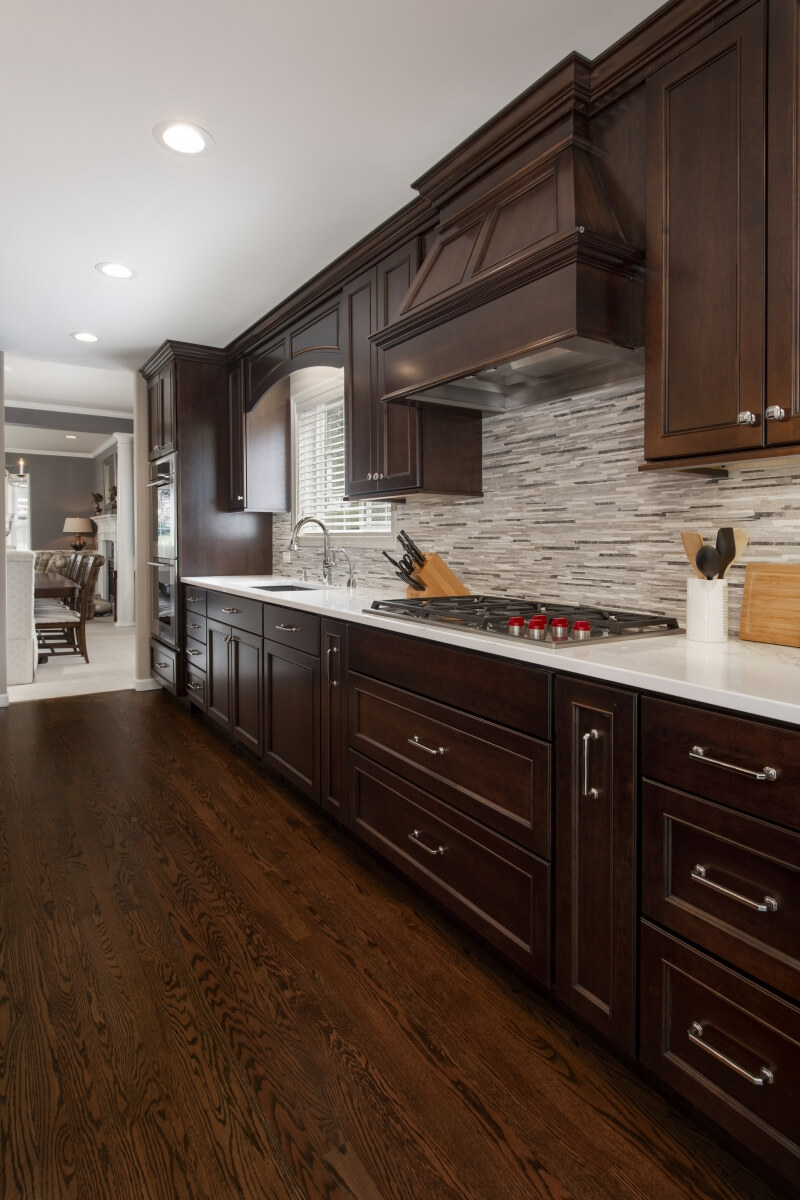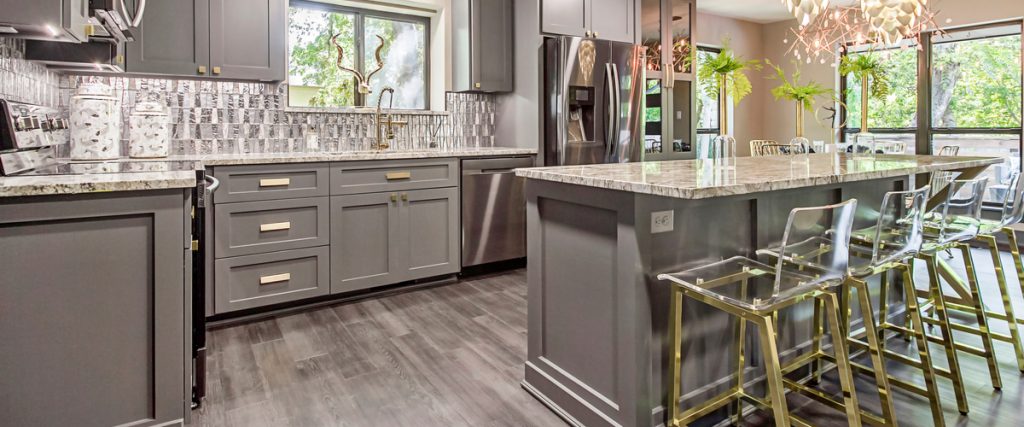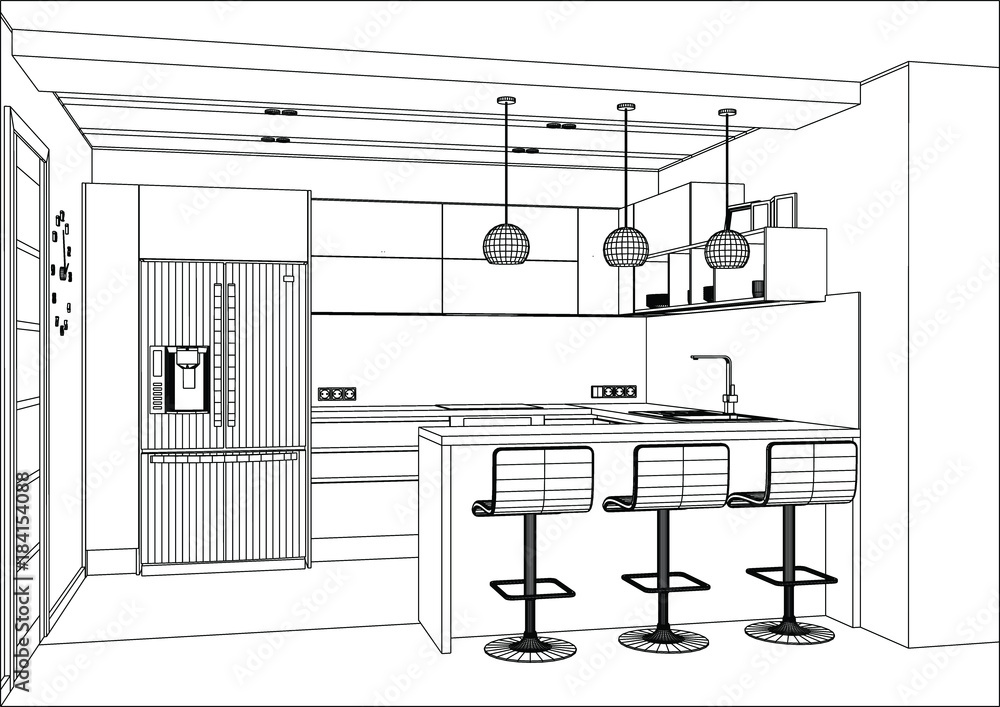When it comes to kitchen design, one element that often gets overlooked is the use of angled walls. While most kitchens are designed with straight walls, incorporating angled walls can add a unique and stylish touch to your space. However, like any design element, there are both pros and cons to consider when using angled walls in your kitchen. Let's take a look at some of them. Pros: 1. Creates visual interest: Angled walls can add a sense of depth and dimension to your kitchen, making it more visually appealing. This can be especially beneficial in smaller kitchens, as angled walls can create the illusion of a larger space. 2. More storage opportunities: Angled walls can provide additional storage opportunities in your kitchen. By utilizing the space created by the angle, you can install shelves, cabinets, or even a hidden pantry. 3. Adds uniqueness: In a world where most kitchens look the same, incorporating angled walls can make your kitchen stand out. It adds a unique touch that can make your space feel more personalized and one-of-a-kind. Cons: 1. Difficult to furnish: The angled walls can make it challenging to find furniture or appliances that fit perfectly against them. This can limit your options and may require custom-made items, which can be quite costly. 2. Can disrupt flow and layout: Depending on the placement and angle of the walls, it can disrupt the flow and layout of your kitchen. It may also make it challenging to move around, especially if the angle is too sharp. 3. More challenging to clean: Angled walls can make it more challenging to clean and maintain your kitchen. Dust and grime can accumulate in the corners, and reaching these areas may require extra effort.1. Angled walls in kitchen design: Pros and Cons
If you've decided that angled walls are the way to go for your kitchen, here are some tips on how to incorporate them into your design seamlessly: 1. Consider the space: Before implementing angled walls, consider the size and layout of your kitchen. Angled walls work best in larger, open spaces where they won't disrupt the flow and layout too much. 2. Use the angles to your advantage: Instead of trying to fight against the angles, use them to your advantage. For example, you can create a cozy breakfast nook in the corner of an angled wall or install a built-in seating area along an angled wall. 3. Balance with straight lines: To avoid overwhelming the space, balance the angled walls with straight lines. This can be achieved by using straight countertops, cabinets, or even a straight kitchen island. 4. Add lighting: Angled walls can create shadows and dark corners in your kitchen. To combat this, incorporate lighting into the design. This can include recessed lighting, pendant lights, or under-cabinet lighting.2. How to incorporate angled walls in your kitchen design
Angled walls don't have to be limited to just adding visual interest or storage opportunities. Here are some creative ways to use angled walls in your kitchen design: 1. Create a focal point: An angled wall can be the perfect spot to create a focal point in your kitchen. This can include a statement backsplash, a unique material, or a bold color choice. 2. Incorporate a window: If your angled wall is located near an exterior wall, consider incorporating a window. This can bring in natural light and make the space feel more open and airy. 3. Utilize the space for appliances: If you're struggling to find space for certain appliances, consider using the angled wall. For example, you can install a built-in oven or microwave in the angled wall, freeing up counter space. 4. Use as a design divider: Angled walls can be used to separate different areas within an open concept kitchen. This can help define the space and add a touch of privacy without closing off the area completely.3. Creative ways to use angled walls in kitchen design
When it comes to choosing between angled walls and straight walls in kitchen design, there is no right or wrong answer. It ultimately depends on your personal preferences and the layout of your space. Here are some points to consider: 1. Straight walls: Straight walls are more traditional and can provide a clean and streamlined look to your kitchen. They are also easier to furnish and decorate. 2. Angled walls: Angled walls can add a unique touch to your kitchen and create a sense of depth and dimension. However, they can be more challenging to work with and may require custom-made items.4. Angled walls vs. straight walls in kitchen design: Which is better?
While angled walls can add a stylish touch to your kitchen, it's essential to also consider functionality. Here are some tips for designing a functional kitchen with angled walls: 1. Plan the layout carefully: Before incorporating angled walls, carefully plan the layout of your kitchen. Consider the placement of appliances, workspaces, and traffic flow to ensure the angles don't disrupt functionality. 2. Maximize storage opportunities: As mentioned earlier, angled walls can provide additional storage opportunities. Take advantage of this by incorporating shelves, cabinets, or even a built-in pantry. 3. Keep it simple: When working with angled walls, it's best to keep the design simple and clean. This will prevent the space from feeling cluttered and overwhelming. 4. Use the angles to create a cohesive design: Instead of fighting against the angles, use them to create a cohesive design. This can include incorporating the same angle in different areas of the kitchen or repeating a similar shape in the decor.5. Tips for designing a functional kitchen with angled walls
Angled walls can be a great solution for maximizing space in a small kitchen. Here are some ways to make the most out of angled walls in a small kitchen: 1. Keep it light and bright: In small spaces, it's essential to keep the design light and bright to make the room feel more open. This can include using light colors, ample lighting, and incorporating reflective surfaces. 2. Utilize the corners: Angled walls can create awkward corners in a small kitchen, but they can also provide additional storage opportunities. Consider installing shelves or a corner cabinet to make use of these spaces. 3. Incorporate a kitchen island: A kitchen island can provide extra counter space and storage in a small kitchen. Consider incorporating an angled wall into the island design to add a unique touch. 4. Use the angles to create flow: In small spaces, it's essential to create a sense of flow to avoid the space feeling cramped. Use the angles to your advantage by creating a flow that leads from one end of the kitchen to the other.6. Angled walls in small kitchen design: Maximizing space
As mentioned earlier, angled walls can have a significant impact on the layout and flow of your kitchen. Here are some factors to consider when incorporating angled walls into your kitchen design: 1. Traffic flow: Consider how the angled walls may affect traffic flow in your kitchen. Will it make it more challenging to move around or create a more natural flow? 2. Placement of appliances: The placement of appliances is crucial in any kitchen, but it becomes even more critical when incorporating angled walls. Consider where appliances will fit best and how they will affect the overall flow of the space. 3. Workspaces: It's essential to have functional workspaces in your kitchen, such as a designated cooking area, prep area, and cleaning area. Consider how the angled walls may affect these workspaces and adjust accordingly. 4. Balance and symmetry: Angled walls can disrupt the balance and symmetry in your kitchen design. Consider how you can use other design elements, such as lighting and furniture placement, to create balance and symmetry.7. The impact of angled walls on kitchen layout and flow
If you're looking to create a modern and unique kitchen design, incorporating angled walls can be a great way to achieve this. Here are some tips on using angled walls in a modern kitchen: 1. Use sleek and clean lines: Modern design is all about clean and sleek lines. When working with angled walls, keep the design simple and avoid any unnecessary details or clutter. 2. Incorporate a monochromatic color scheme: Monochromatic color schemes are a staple in modern design. Consider using different shades of the same color to create a cohesive and clean look. 3. Mix materials: Mixing materials, such as wood, metal, and stone, can add interest and texture to a modern kitchen design. Incorporate these materials in the countertops, backsplash, and even the angled walls themselves. 4. Keep it functional: While modern design is all about aesthetics, it's essential to also consider functionality. Keep the design functional by incorporating ample storage, proper lighting, and a practical layout.8. Using angled walls to create a unique and modern kitchen design
Open concept kitchens have become increasingly popular in recent years, and incorporating angled walls can take this design to the next level. Here's how to use angled walls in an open concept kitchen: 1. Define the space: Angled walls can be used to define different areas within an open concept kitchen, such as the cooking and dining areas. This can create a sense of separation without closing off the space completely. 2. Create a feature wall: An angled wall can be the perfect spot to create a feature wall in an open concept kitchen. This can include a bold color, a patterned wallpaper, or a unique material. 3. Use as a design divider: As mentioned earlier, angled walls can be used to separate different areas within an open concept kitchen. This can help define the space and add a touch of privacy without closing off the area completely. 4. Incorporate a kitchen island: A kitchen island is a staple in open concept kitchens, and incorporating an angled wall into the island design can add a unique touch and make the space feel more dynamic.9. Incorporating angled walls in open concept kitchen designs
Once your kitchen with angled walls is complete, it's time to decorate and style them to make them truly stand out. Here are some tips to consider: 1. Keep it simple: When it comes to decorating angled walls, less is more. Keep the decor simple and clean to avoid overwhelming the space. 2. Incorporate plants: Plants can add a touch of freshness and life to any space, including angled walls. Consider hanging plants or placing potted plants on shelves or countertops along the angled walls. 3. Use the walls for artwork: Angled walls can be the perfect spot to showcase artwork. Consider hanging a statement piece, a gallery wall, or a series of smaller pieces along the angled walls. 4. Add texture: Adding texture can add interest and depth to angled walls. This can include using different materials, such as wood, metal, or wallpaper, or incorporating textured decor items, such as woven baskets or ceramic vases.10. How to decorate and style angled walls in kitchen design
The Benefits of Angled Walls in Kitchen Design

Maximizing Space and Functionality
 When it comes to designing a kitchen, one of the most important factors to consider is space. Angled walls offer a unique opportunity to maximize the space in a kitchen and make it more functional. By angling walls, you can create more counter space, storage, and even room for additional appliances. This allows for a more efficient use of the kitchen and makes it easier to move around and prepare meals.
When it comes to designing a kitchen, one of the most important factors to consider is space. Angled walls offer a unique opportunity to maximize the space in a kitchen and make it more functional. By angling walls, you can create more counter space, storage, and even room for additional appliances. This allows for a more efficient use of the kitchen and makes it easier to move around and prepare meals.
Creating Visual Interest
 In addition to maximizing space, angled walls can also add a touch of visual interest to a kitchen design. Traditional kitchens with straight walls can appear dull and lackluster, but incorporating angled walls can add depth and dimension to the space. This can be especially beneficial in smaller kitchens, as it can create the illusion of a larger and more open space.
In addition to maximizing space, angled walls can also add a touch of visual interest to a kitchen design. Traditional kitchens with straight walls can appear dull and lackluster, but incorporating angled walls can add depth and dimension to the space. This can be especially beneficial in smaller kitchens, as it can create the illusion of a larger and more open space.
Enhancing Natural Lighting
 Another advantage of angled walls in kitchen design is their ability to enhance natural lighting. By angling walls towards windows or skylights, you can allow more natural light to enter the kitchen. This not only creates a brighter and more inviting atmosphere, but it can also reduce the need for artificial lighting during the day, saving energy and money.
Another advantage of angled walls in kitchen design is their ability to enhance natural lighting. By angling walls towards windows or skylights, you can allow more natural light to enter the kitchen. This not only creates a brighter and more inviting atmosphere, but it can also reduce the need for artificial lighting during the day, saving energy and money.
Adding Architectural Interest
 Angled walls can also add architectural interest to the kitchen, making it stand out from traditional designs. By incorporating unique angles and shapes, you can create a more modern and visually appealing space. This is especially beneficial for open concept kitchens, as the angled walls can help define the space and create a sense of separation from other areas in the home.
Angled walls can also add architectural interest to the kitchen, making it stand out from traditional designs. By incorporating unique angles and shapes, you can create a more modern and visually appealing space. This is especially beneficial for open concept kitchens, as the angled walls can help define the space and create a sense of separation from other areas in the home.
Incorporating Design Elements
 Lastly, angled walls in kitchen design provide the perfect opportunity to incorporate various design elements. From built-in shelving and cabinets to creative backsplash designs, the angles in the walls offer a blank canvas for you to add your personal touch and make the space truly unique.
In conclusion, angled walls offer numerous benefits when it comes to kitchen design. From maximizing space and functionality to adding visual interest and incorporating design elements, they can transform a traditional kitchen into a modern and functional space. So next time you're considering a kitchen remodel, don't be afraid to think outside the box and incorporate angled walls into your design.
Lastly, angled walls in kitchen design provide the perfect opportunity to incorporate various design elements. From built-in shelving and cabinets to creative backsplash designs, the angles in the walls offer a blank canvas for you to add your personal touch and make the space truly unique.
In conclusion, angled walls offer numerous benefits when it comes to kitchen design. From maximizing space and functionality to adding visual interest and incorporating design elements, they can transform a traditional kitchen into a modern and functional space. So next time you're considering a kitchen remodel, don't be afraid to think outside the box and incorporate angled walls into your design.




















































/the_house_acc2-0574751f8135492797162311d98c9d27.png)























































